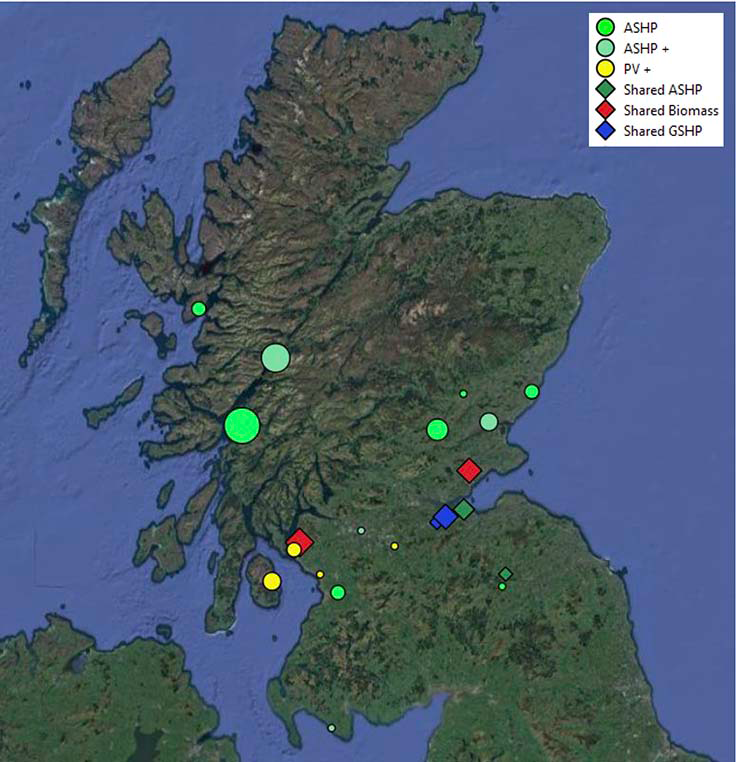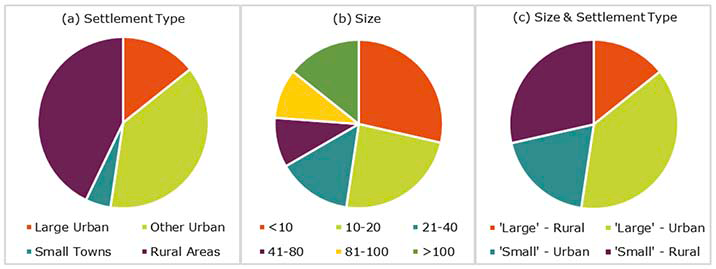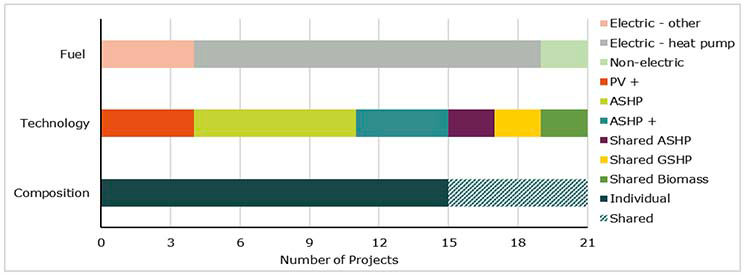Renewable and zero emissions heating systems in affordable housing projects: evaluation
An evaluation of renewable and zero emissions heating systems in 21 Scottish affordable housing projects. This study assesses the estimated, actual, and counterfactual costs of the projects’ heating systems and determines the drivers behind decision making.
4. Overview of affordable housing projects
An overview of the projects participating in the evaluation is presented in Table 4. The table shows their locations by local authority area; the type of heating system; the target sustainability standard; construction status and project size (the number of affordable housing units). Several technologies are abbreviated here and throughout the report, with GSHP, ASHP and MVHR denoting Ground Source Heat Pumps, Air Source Heat Pumps and Mechanical Ventilation with Heat Recovery, respectively.
| # | Local Authority Area | Heating system | Sustainability Target | Status | Size |
|---|---|---|---|---|---|
| 1 | North Ayrshire | Solar PV & Electric boilers | Bronze + Silver aspects | On site | 34 |
| 2 | North Ayrshire | Solar PV & Electric boilers | Bronze + Silver aspects | On site | 18 |
| 3 | North Ayrshire | Solar PV & Heat battery |
Silver + Gold aspects | Complete | 4 |
| 4 | North Lanarkshire | Solar PV & Heat battery |
Gold | Complete | 2 |
| 5 | Perth & Kinross | ASHP | Bronze + Silver aspects | Pre-construction | 4 |
| 6 | Argyll & Bute | ASHP | Silver | On site | 300 |
| 7 | Angus | ASHP | SAP - 81 | Complete | 10 |
| 8 | Scottish Borders | ASHP | Silver + Gold aspects | Pre-construction | 4 |
| 9 | Highland | ASHP | Bronze | Pre-construction | 14 |
| 10 | South Ayrshire | ASHP | Unconfirmed | Delayed | 14 |
| 11 | Perth & Kinross | ASHP | Unconfirmed | Delayed | 50 |
| 12 | Dundee City | ASHP & MVHR | Unconfirmed | Delayed | 30 |
| 13 | Highland | ASHP, Solar PV & Heat battery |
Bronze + Silver aspects | Pre-construction | 117 |
| 14 | Glasgow City | ASHP, MVHR & Heat battery | Platinum | Complete | 2 |
| 15 | Dumfries & Galloway | ASHP, MVHR & solar thermal | Silver | On site | 5 |
| 16 | Scottish Borders | Shared ASHP | Silver + Gold aspects | Pre-construction | 21 |
| 17 | Edinburgh City | Shared ASHP | 100% above Silver | Pre-construction | 41 |
| 18 | West Lothian | Shared GSHP | Silver | Pre-construction | 16 |
| 19 | Edinburgh City | Shared GSHP | Bronze + Silver aspects | On site | 84 |
| 20 | Fife | Shared Biomass | Bronze + Silver aspects | On site | 85 |
| 21 | North Ayrshire | Shared Biomass | Bronze + Silver aspects | On site | 123 |
Of the 21 projects initially included in the evaluation scope, three were not able to participate due to delays. As such, we were not able to confirm all of the information for these projects, hence they are not referenced in any further sections of this report.
The project locations are shown below in Figure 2, where they are categorised according to the type of heating system. Where the category includes a '+' symbol, this indicates that there are several additional technologies included in the heating systems. The markers also give an indication of the size of each development (not to scale).

Figure 2 shows that the majorty of the projects participating in this evaluation are located close to or within the Central Belt of Scotland. There are also several remote, rural projects, including three located on Scottish islands.
Figure 3 demonstrates the split between settlement types according to the Scottish Government Urban Rural Classification, as well as the significant variation in project size. Whilst most projects have no more than 20 homes, there are a few with more than 100 homes, the largest having 300 homes. In Figure 3(c) projects are classified as 'large' if they comprise more than 20 affordable housing units. These factors have been presented here as they are likely influencers of a housing project's design, including its heating systems. The given distribution of size and settlement type indicates the variability in the sample and the potential broad range of factors that could impact heating technology choice.

Figure 2 also indicates that there is a broad variation in the heating systems specified across the various projects. This is further demonstrated in Figure 4, which shows the chosen technology, fuel type and composition of the 21 heating systems across the original projects. Clearly, heat pumps are used across the majority of the projects, with indvidual ASHPs being the most common.

The projects are classified by what sustainability standard their energy systems are designed to achieve in Figure 5. The three delayed projects have not been included here as the targets were not confirmed and some of the other targets may be subject to change. The information provided indicates that the vast majority of the projects have heating systems that are designed to meet Silver Standard. Projects achieving Silver or a higher standard will meet the Affordable Housing Supply Programme's greener standard.
The two projects denoted as 'Higher' in Figure 5 include one Platinum project (which is notably the only project in this study to employ hybrid gas boiler air-source heat pump systems) and another which was yet to select a sustainability standard but aimed to be "100% improved versus Silver standard". The project listed as 'Other' was devised before the standards became mandatory, but (based on the target SAP score of 81 for the homes) would likely achieve Silver standard for its heating systems. The single 'Bronze' project was not able to afford Silver standard within the project budget.

The Bronze and Platinum projects were not able to provide cost breakdowns for their heating systems for work package 1 of this study. The other project aiming to meet a 'Higher' standard than Gold had not designed its heating systems yet and therefore had not yet costed this. The cost data presented in subsequent sections of this report relates only to projects that meet Gold and Silver (or equivalent) sustainability standards.
Contact
Email: 2024heatstandard@gov.scot
There is a problem
Thanks for your feedback